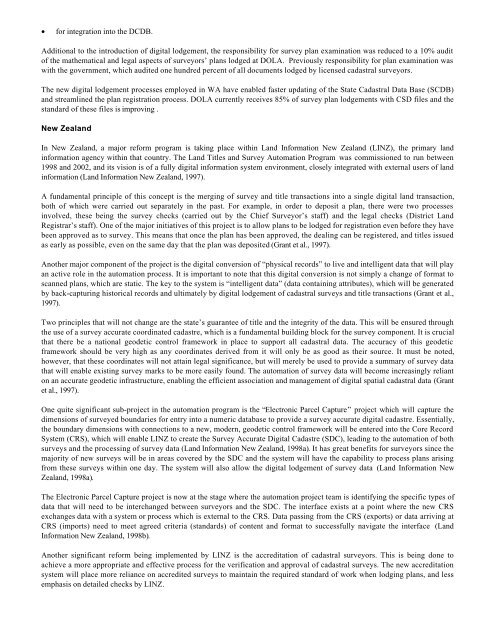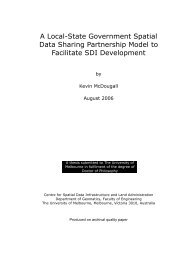Digital Lodgement of Cadastral Survey Data in Australia - Centre for ...
Digital Lodgement of Cadastral Survey Data in Australia - Centre for ...
Digital Lodgement of Cadastral Survey Data in Australia - Centre for ...
Create successful ePaper yourself
Turn your PDF publications into a flip-book with our unique Google optimized e-Paper software.
• <strong>for</strong> <strong>in</strong>tegration <strong>in</strong>to the DCDB.<br />
Additional to the <strong>in</strong>troduction <strong>of</strong> digital lodgement, the responsibility <strong>for</strong> survey plan exam<strong>in</strong>ation was reduced to a 10% audit<br />
<strong>of</strong> the mathematical and legal aspects <strong>of</strong> surveyors’ plans lodged at DOLA. Previously responsibility <strong>for</strong> plan exam<strong>in</strong>ation was<br />
with the government, which audited one hundred percent <strong>of</strong> all documents lodged by licensed cadastral surveyors.<br />
The new digital lodgement processes employed <strong>in</strong> WA have enabled faster updat<strong>in</strong>g <strong>of</strong> the State <strong>Cadastral</strong> <strong>Data</strong> Base (SCDB)<br />
and streaml<strong>in</strong>ed the plan registration process. DOLA currently receives 85% <strong>of</strong> survey plan lodgements with CSD files and the<br />
standard <strong>of</strong> these files is improv<strong>in</strong>g .<br />
New Zealand<br />
In New Zealand, a major re<strong>for</strong>m program is tak<strong>in</strong>g place with<strong>in</strong> Land In<strong>for</strong>mation New Zealand (LINZ), the primary land<br />
<strong>in</strong><strong>for</strong>mation agency with<strong>in</strong> that country. The Land Titles and <strong>Survey</strong> Automation Program was commissioned to run between<br />
1998 and 2002, and its vision is <strong>of</strong> a fully digital <strong>in</strong><strong>for</strong>mation system environment, closely <strong>in</strong>tegrated with external users <strong>of</strong> land<br />
<strong>in</strong><strong>for</strong>mation (Land In<strong>for</strong>mation New Zealand, 1997).<br />
A fundamental pr<strong>in</strong>ciple <strong>of</strong> this concept is the merg<strong>in</strong>g <strong>of</strong> survey and title transactions <strong>in</strong>to a s<strong>in</strong>gle digital land transaction,<br />
both <strong>of</strong> which were carried out separately <strong>in</strong> the past. For example, <strong>in</strong> order to deposit a plan, there were two processes<br />
<strong>in</strong>volved, these be<strong>in</strong>g the survey checks (carried out by the Chief <strong>Survey</strong>or’s staff) and the legal checks (District Land<br />
Registrar’s staff). One <strong>of</strong> the major <strong>in</strong>itiatives <strong>of</strong> this project is to allow plans to be lodged <strong>for</strong> registration even be<strong>for</strong>e they have<br />
been approved as to survey. This means that once the plan has been approved, the deal<strong>in</strong>g can be registered, and titles issued<br />
as early as possible, even on the same day that the plan was deposited (Grant et al., 1997).<br />
Another major component <strong>of</strong> the project is the digital conversion <strong>of</strong> “physical records” to live and <strong>in</strong>telligent data that will play<br />
an active role <strong>in</strong> the automation process. It is important to note that this digital conversion is not simply a change <strong>of</strong> <strong>for</strong>mat to<br />
scanned plans, which are static. The key to the system is “<strong>in</strong>telligent data” (data conta<strong>in</strong><strong>in</strong>g attributes), which will be generated<br />
by back-captur<strong>in</strong>g historical records and ultimately by digital lodgement <strong>of</strong> cadastral surveys and title transactions (Grant et al.,<br />
1997).<br />
Two pr<strong>in</strong>ciples that will not change are the state’s guarantee <strong>of</strong> title and the <strong>in</strong>tegrity <strong>of</strong> the data. This will be ensured through<br />
the use <strong>of</strong> a survey accurate coord<strong>in</strong>ated cadastre, which is a fundamental build<strong>in</strong>g block <strong>for</strong> the survey component. It is crucial<br />
that there be a national geodetic control framework <strong>in</strong> place to support all cadastral data. The accuracy <strong>of</strong> this geodetic<br />
framework should be very high as any coord<strong>in</strong>ates derived from it will only be as good as their source. It must be noted,<br />
however, that these coord<strong>in</strong>ates will not atta<strong>in</strong> legal significance, but will merely be used to provide a summary <strong>of</strong> survey data<br />
that will enable exist<strong>in</strong>g survey marks to be more easily found. The automation <strong>of</strong> survey data will become <strong>in</strong>creas<strong>in</strong>gly reliant<br />
on an accurate geodetic <strong>in</strong>frastructure, enabl<strong>in</strong>g the efficient association and management <strong>of</strong> digital spatial cadastral data (Grant<br />
et al., 1997).<br />
One quite significant sub-project <strong>in</strong> the automation program is the “Electronic Parcel Capture” project which will capture the<br />
dimensions <strong>of</strong> surveyed boundaries <strong>for</strong> entry <strong>in</strong>to a numeric database to provide a survey accurate digital cadastre. Essentially,<br />
the boundary dimensions with connections to a new, modern, geodetic control framework will be entered <strong>in</strong>to the Core Record<br />
System (CRS), which will enable LINZ to create the <strong>Survey</strong> Accurate <strong>Digital</strong> Cadastre (SDC), lead<strong>in</strong>g to the automation <strong>of</strong> both<br />
surveys and the process<strong>in</strong>g <strong>of</strong> survey data (Land In<strong>for</strong>mation New Zealand, 1998a). It has great benefits <strong>for</strong> surveyors s<strong>in</strong>ce the<br />
majority <strong>of</strong> new surveys will be <strong>in</strong> areas covered by the SDC and the system will have the capability to process plans aris<strong>in</strong>g<br />
from these surveys with<strong>in</strong> one day. The system will also allow the digital lodgement <strong>of</strong> survey data (Land In<strong>for</strong>mation New<br />
Zealand, 1998a).<br />
The Electronic Parcel Capture project is now at the stage where the automation project team is identify<strong>in</strong>g the specific types <strong>of</strong><br />
data that will need to be <strong>in</strong>terchanged between surveyors and the SDC. The <strong>in</strong>terface exists at a po<strong>in</strong>t where the new CRS<br />
exchanges data with a system or process which is external to the CRS. <strong>Data</strong> pass<strong>in</strong>g from the CRS (exports) or data arriv<strong>in</strong>g at<br />
CRS (imports) need to meet agreed criteria (standards) <strong>of</strong> content and <strong>for</strong>mat to successfully navigate the <strong>in</strong>terface (Land<br />
In<strong>for</strong>mation New Zealand, 1998b).<br />
Another significant re<strong>for</strong>m be<strong>in</strong>g implemented by LINZ is the accreditation <strong>of</strong> cadastral surveyors. This is be<strong>in</strong>g done to<br />
achieve a more appropriate and effective process <strong>for</strong> the verification and approval <strong>of</strong> cadastral surveys. The new accreditation<br />
system will place more reliance on accredited surveys to ma<strong>in</strong>ta<strong>in</strong> the required standard <strong>of</strong> work when lodg<strong>in</strong>g plans, and less<br />
emphasis on detailed checks by LINZ.







